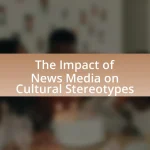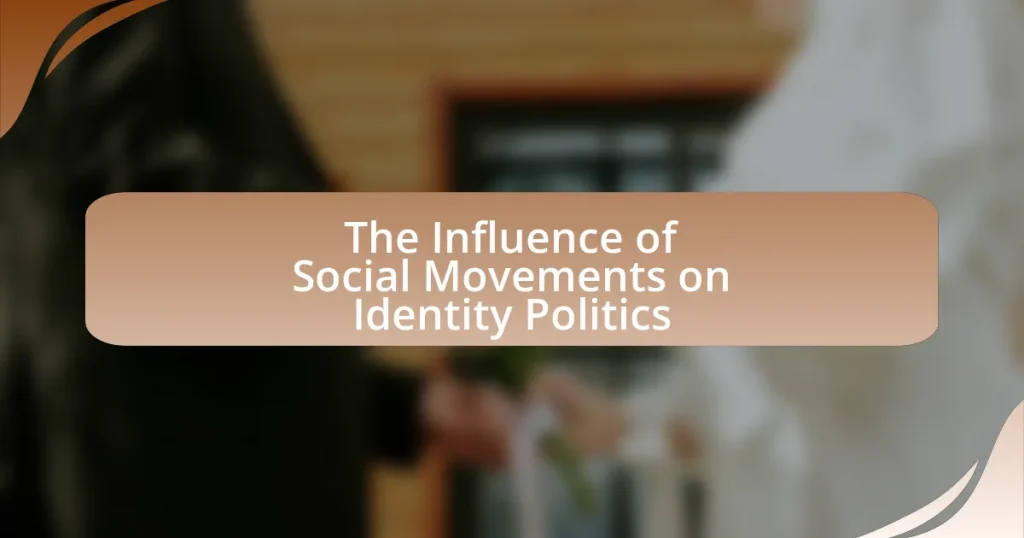The article examines the influence of social movements on identity politics, highlighting how these movements mobilize individuals around shared identities and collective grievances. It discusses key historical examples, such as the Civil Rights Movement and LGBTQ+ activism, illustrating their impact on legislative changes and societal attitudes. The article also explores the characteristics of social movements, including collective identity and mobilization strategies, and emphasizes the importance of understanding their role in shaping political discourse and empowering marginalized communities. Additionally, it addresses contemporary trends, challenges, and effective strategies for enhancing the influence of social movements on identity politics.
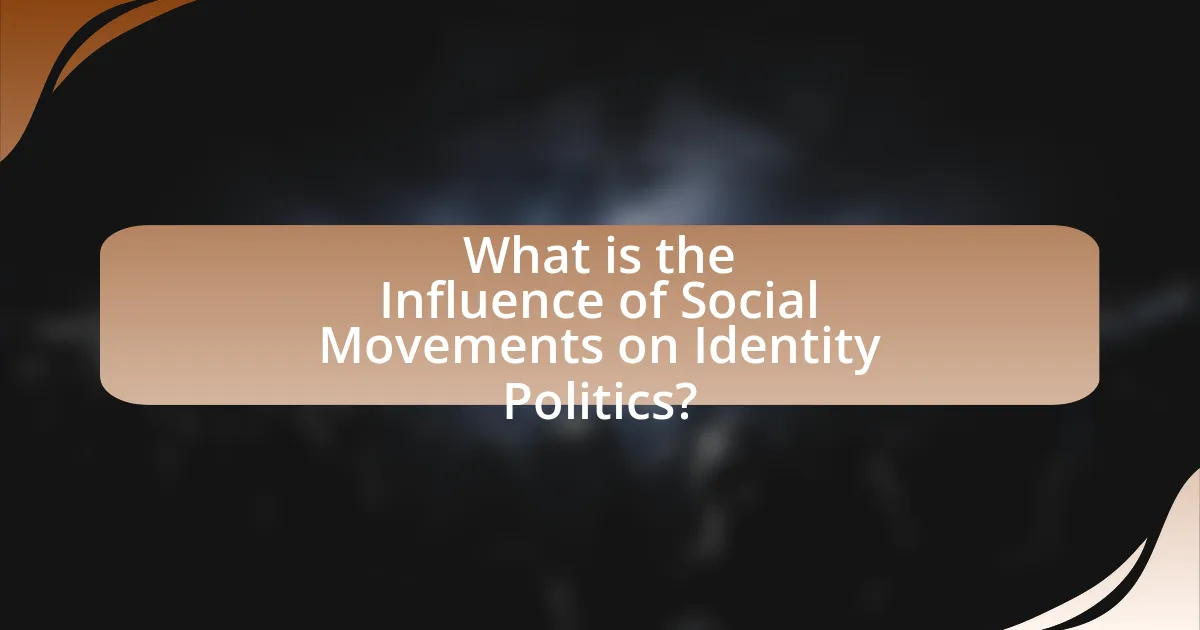
What is the Influence of Social Movements on Identity Politics?
Social movements significantly shape identity politics by mobilizing individuals around shared identities and collective grievances. These movements, such as the Civil Rights Movement and LGBTQ+ rights activism, create a platform for marginalized groups to assert their identities and demand recognition and rights. For instance, the Civil Rights Movement in the 1960s led to the establishment of legal protections against racial discrimination, fundamentally altering the political landscape and empowering African Americans. Similarly, the LGBTQ+ movement has influenced public policy and societal attitudes, resulting in the legalization of same-sex marriage in many countries. These examples illustrate how social movements not only raise awareness but also drive legislative changes that affirm the identities and rights of specific groups, thereby reinforcing the connection between social movements and identity politics.
How do social movements shape identity politics?
Social movements shape identity politics by mobilizing collective identities and fostering a sense of belonging among marginalized groups. These movements, such as the Civil Rights Movement and LGBTQ+ rights activism, create platforms for individuals to express their identities and advocate for their rights. For instance, the Civil Rights Movement in the 1960s galvanized African Americans to unite under a shared identity, leading to significant legislative changes like the Civil Rights Act of 1964. This illustrates how social movements not only articulate the grievances of specific identities but also influence broader political discourse, thereby reshaping societal norms and policies related to those identities.
What are the key characteristics of social movements that impact identity politics?
Key characteristics of social movements that impact identity politics include collective identity, mobilization strategies, and the framing of issues. Collective identity refers to the shared sense of belonging among members, which fosters solidarity and strengthens group cohesion. Mobilization strategies involve organized efforts to engage participants and advocate for change, often utilizing grassroots tactics and social media to reach broader audiences. The framing of issues is crucial, as it shapes how movements articulate their goals and grievances, influencing public perception and political discourse. For instance, the Civil Rights Movement effectively framed racial equality as a moral imperative, garnering widespread support and legislative change. These characteristics collectively enhance the movements’ ability to influence identity politics by shaping societal narratives and advocating for marginalized groups.
How do social movements mobilize individuals around identity issues?
Social movements mobilize individuals around identity issues by creating a shared sense of belonging and collective identity among participants. They utilize symbols, narratives, and collective experiences that resonate with individuals’ personal identities, fostering emotional connections and a sense of urgency. For instance, the Civil Rights Movement in the United States effectively mobilized African Americans by emphasizing shared experiences of discrimination and the quest for equality, leading to widespread participation in protests and advocacy. This mobilization is often reinforced through social media platforms, which amplify messages and connect individuals with similar identities, further solidifying group cohesion and action.
Why is understanding this influence important?
Understanding the influence of social movements on identity politics is important because it shapes societal norms and individual identities. Social movements drive awareness and advocacy for marginalized groups, leading to policy changes and greater representation. For instance, the Civil Rights Movement in the United States significantly altered public perceptions and laws regarding racial equality, demonstrating how collective action can transform political landscapes and individual self-conceptions. This understanding helps in analyzing current social dynamics and predicting future trends in political engagement and identity formation.
What implications does this influence have on political discourse?
The influence of social movements on identity politics significantly shapes political discourse by amplifying marginalized voices and altering the framing of political issues. This transformation leads to a more inclusive dialogue that challenges traditional power structures and promotes social justice. For instance, movements like Black Lives Matter have shifted discussions around race and policing, compelling policymakers to address systemic inequalities. Research indicates that social movements can increase political engagement among underrepresented groups, thereby diversifying the electorate and influencing policy outcomes. This dynamic illustrates how social movements not only impact individual identities but also reshape the broader political landscape.
How does this influence affect marginalized communities?
Social movements significantly influence marginalized communities by amplifying their voices and advocating for their rights. This influence fosters greater awareness of social injustices, leading to policy changes that address systemic inequalities. For example, the Black Lives Matter movement has highlighted issues of police brutality and racial discrimination, resulting in legislative reforms in various jurisdictions aimed at improving accountability and justice for marginalized groups. Additionally, social movements often provide a platform for collective identity formation, empowering individuals within these communities to unite and mobilize for change, as evidenced by the increased participation of LGBTQ+ individuals in advocacy efforts following the Stonewall riots.
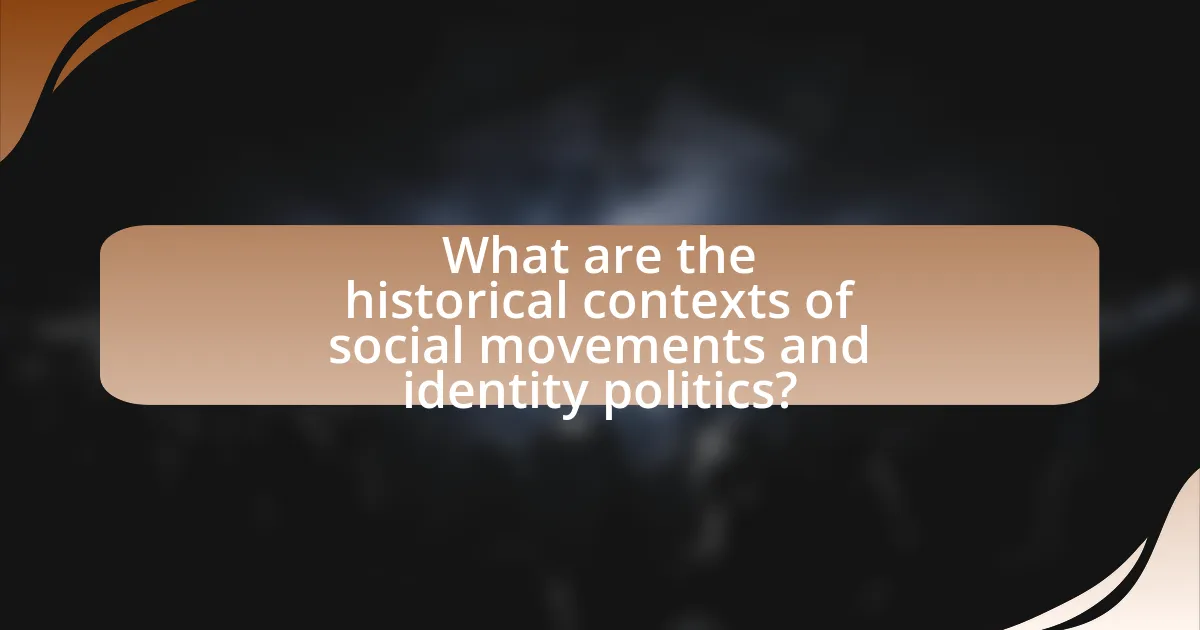
What are the historical contexts of social movements and identity politics?
Social movements and identity politics have historical contexts rooted in struggles for civil rights, social justice, and recognition of marginalized groups. The civil rights movement in the United States during the 1950s and 1960s exemplifies this, as activists sought to dismantle systemic racism and promote equality, leading to significant legislative changes like the Civil Rights Act of 1964. Similarly, the feminist movement emerged in the late 19th and early 20th centuries, advocating for women’s suffrage and later expanding to issues of gender equality and reproductive rights. The LGBTQ+ rights movement gained momentum in the late 20th century, particularly after events like the Stonewall Riots in 1969, which catalyzed activism for sexual orientation and gender identity recognition. These movements illustrate how social dynamics, political contexts, and cultural shifts have shaped identity politics, emphasizing the importance of collective action in achieving social change.
How have historical social movements influenced contemporary identity politics?
Historical social movements have significantly shaped contemporary identity politics by establishing frameworks for marginalized groups to assert their rights and identities. For instance, the Civil Rights Movement of the 1960s laid the groundwork for ongoing struggles for racial equality, influencing modern movements like Black Lives Matter, which seeks to address systemic racism and police violence. Similarly, the feminist movements of the late 20th century have informed current discussions around gender identity and LGBTQ+ rights, as seen in the advocacy for transgender rights today. These historical movements provided essential strategies, language, and solidarity that contemporary identity politics utilize to mobilize support and challenge societal norms.
What role did the Civil Rights Movement play in shaping identity politics?
The Civil Rights Movement significantly shaped identity politics by advocating for the recognition and rights of marginalized groups, particularly African Americans. This movement highlighted the importance of racial identity and collective action, leading to the formation of various identity-based political groups that sought to address specific injustices. For instance, the Civil Rights Act of 1964 and the Voting Rights Act of 1965 were direct outcomes of the movement, establishing legal frameworks that empowered individuals to assert their identities and fight against discrimination. Furthermore, the movement inspired other social movements, such as those for women’s rights and LGBTQ+ rights, demonstrating how identity politics can be mobilized to challenge systemic inequalities.
How did feminist movements contribute to the evolution of identity politics?
Feminist movements significantly contributed to the evolution of identity politics by advocating for the recognition of women’s diverse experiences and identities within the broader social and political landscape. This advocacy led to the understanding that identity is multifaceted, encompassing not only gender but also race, class, sexuality, and other social categories. For instance, the second-wave feminist movement in the 1960s and 1970s emphasized the intersectionality of gender with other identities, as articulated by scholars like Kimberlé Crenshaw, who highlighted how overlapping social identities can lead to unique forms of discrimination. This framework laid the groundwork for contemporary identity politics, which seeks to address the specific needs and rights of various marginalized groups, thereby reshaping political discourse and activism to be more inclusive and representative of diverse identities.
What lessons can be learned from past movements?
Past movements teach that collective action can effectively challenge systemic injustices and reshape societal norms. For instance, the Civil Rights Movement in the United States demonstrated how organized protests and legal challenges could dismantle segregation laws, leading to significant legislative changes like the Civil Rights Act of 1964. Additionally, movements such as the LGBTQ+ rights movement have shown the importance of visibility and representation in achieving legal recognition and social acceptance, culminating in milestones like the legalization of same-sex marriage in many countries. These examples illustrate that strategic organization, clear messaging, and coalition-building are crucial for the success of social movements in influencing identity politics and enacting change.
How can past successes and failures inform current identity politics?
Past successes and failures significantly inform current identity politics by shaping the strategies and narratives employed by social movements. Historical achievements, such as the Civil Rights Movement’s success in securing voting rights, provide a framework for contemporary movements to advocate for equality and justice, demonstrating the effectiveness of organized activism. Conversely, failures, such as the lack of comprehensive reforms after the Stonewall Riots, highlight the challenges that marginalized groups face, prompting current activists to adopt more inclusive and intersectional approaches. These historical contexts guide current identity politics by illustrating both the potential for change and the obstacles that must be navigated, ultimately influencing the tactics and goals of modern social movements.
What strategies have proven effective in past social movements?
Effective strategies in past social movements include grassroots organizing, coalition-building, and strategic use of media. Grassroots organizing mobilizes community members to participate actively, as seen in the Civil Rights Movement, where local leaders engaged citizens to demand change. Coalition-building, exemplified by the Women’s March, unites diverse groups to amplify voices and increase impact. Additionally, strategic use of media, such as social media campaigns during the Arab Spring, has proven essential in raising awareness and mobilizing support quickly. These strategies have consistently demonstrated their effectiveness in advancing social change and influencing identity politics.
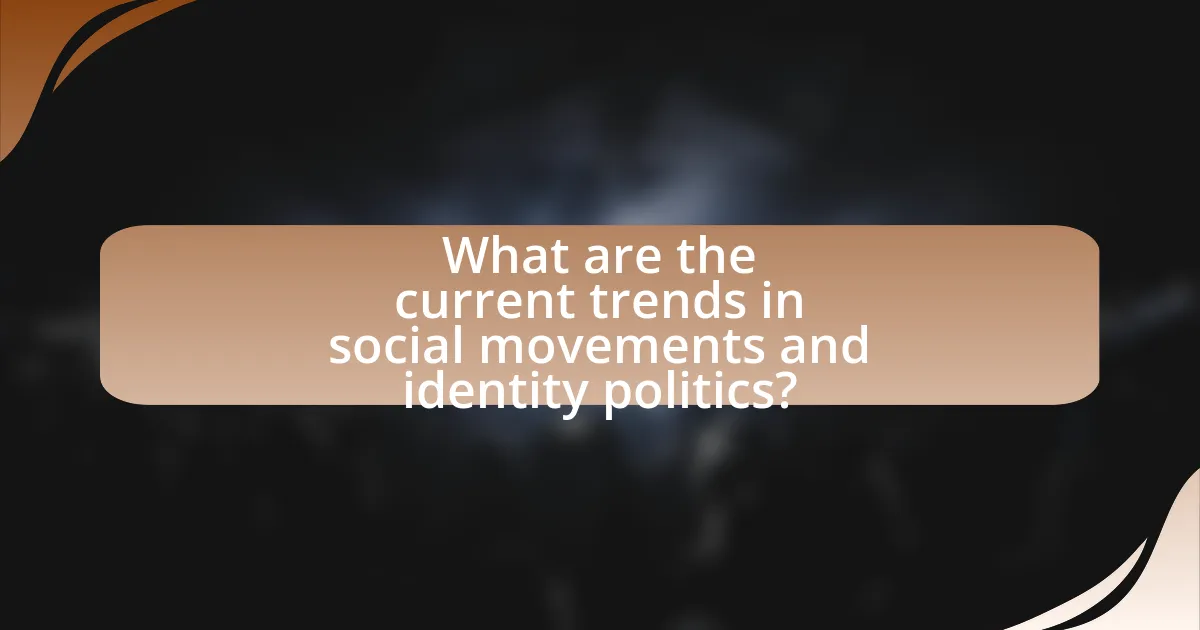
What are the current trends in social movements and identity politics?
Current trends in social movements and identity politics include a rise in intersectionality, digital activism, and a focus on climate justice. Intersectionality emphasizes the interconnected nature of social categorizations, leading to a more nuanced understanding of identity and oppression. Digital activism has gained momentum, with social media platforms facilitating rapid mobilization and awareness, as seen in movements like Black Lives Matter and #MeToo. Additionally, climate justice has emerged as a critical issue, linking environmental concerns with social equity, as highlighted by youth-led movements advocating for systemic change. These trends reflect a shift towards more inclusive and multifaceted approaches in addressing social issues.
How are modern social movements utilizing technology to influence identity politics?
Modern social movements utilize technology to influence identity politics by leveraging social media platforms for mobilization, awareness, and community building. These platforms enable movements to disseminate information rapidly, engage diverse audiences, and create a sense of belonging among individuals sharing similar identities. For instance, the Black Lives Matter movement effectively used Twitter and Instagram to amplify messages about racial injustice, resulting in widespread protests and policy discussions. Research indicates that social media campaigns can significantly increase public engagement and support for identity-based issues, as seen in the 2017 Women’s March, which mobilized millions globally through online organizing. This demonstrates that technology not only facilitates communication but also shapes the narratives surrounding identity politics, allowing marginalized voices to gain visibility and influence.
What platforms are most effective for mobilizing support around identity issues?
Social media platforms, particularly Twitter, Facebook, and Instagram, are most effective for mobilizing support around identity issues. These platforms facilitate rapid information dissemination, community building, and engagement through hashtags and campaigns, which have been shown to amplify voices and foster solidarity among marginalized groups. For instance, the #BlackLivesMatter movement gained significant traction on Twitter, leading to widespread awareness and mobilization for racial justice. Additionally, Facebook groups have been instrumental in organizing events and discussions that unite individuals around shared identity concerns, as evidenced by the success of various LGBTQ+ advocacy campaigns.
How does social media shape the narrative of identity politics?
Social media shapes the narrative of identity politics by providing a platform for marginalized voices to share their experiences and mobilize support. This democratization of information allows individuals and groups to challenge dominant narratives and create alternative discourses around identity. For instance, movements like #BlackLivesMatter and #MeToo have utilized social media to raise awareness about systemic injustices and foster community solidarity, leading to significant societal discussions and policy changes. Research indicates that social media engagement can amplify the visibility of identity-based issues, as evidenced by a Pew Research Center study showing that 69% of adults in the U.S. believe social media is an important tool for political activism.
What challenges do contemporary social movements face in identity politics?
Contemporary social movements face significant challenges in identity politics, primarily due to fragmentation and intersectionality. Fragmentation occurs when diverse groups within a movement prioritize their specific identities over collective goals, leading to internal conflicts and diluted efforts. For instance, the feminist movement has seen divisions between mainstream feminism and intersectional feminism, which emphasizes the importance of race, class, and sexuality in understanding women’s experiences. Additionally, intersectionality complicates advocacy as movements must address multiple, often conflicting, identities, making it difficult to create unified strategies. This complexity can hinder mobilization and weaken the overall impact of social movements, as seen in the varying priorities among LGBTQ+ activists regarding race and gender issues.
How do intersectionality and diversity complicate identity politics today?
Intersectionality and diversity complicate identity politics today by highlighting the multifaceted nature of individual identities, which often leads to conflicting interests within social movements. Intersectionality, a concept introduced by Kimberlé Crenshaw, emphasizes that individuals experience overlapping social identities—such as race, gender, and class—that shape their unique experiences of oppression and privilege. This complexity can create tensions among groups advocating for social justice, as different identities may prioritize different issues, making it challenging to form a unified front. For instance, a movement focused solely on racial justice may overlook gender-based violence, while a feminist movement may not fully address the needs of women of color. This fragmentation can dilute collective efforts and lead to competition for resources and recognition among various identity groups, complicating the overall effectiveness of identity politics in achieving social change.
What are the risks of fragmentation within social movements?
Fragmentation within social movements poses significant risks, including weakened collective action, diluted messaging, and reduced overall effectiveness. When social movements splinter into smaller factions, they often struggle to maintain a unified front, which can lead to confusion among supporters and potential allies. This disunity can result in competing narratives that undermine the movement’s core objectives, making it difficult to mobilize resources and garner public support. Historical examples, such as the fragmentation seen in the civil rights movement during the 1960s, illustrate how divisions can hinder progress and create opportunities for opposition forces to exploit these rifts. Additionally, research indicates that fragmented movements may face challenges in achieving policy changes, as policymakers often prefer to engage with cohesive groups that present clear demands.
What practical strategies can be employed to enhance the influence of social movements on identity politics?
Practical strategies to enhance the influence of social movements on identity politics include building coalitions, utilizing social media effectively, and engaging in grassroots organizing. Building coalitions allows diverse groups to unite around common goals, amplifying their collective voice and increasing visibility. For instance, the Women’s March in 2017 successfully brought together various organizations advocating for women’s rights, demonstrating the power of collaboration. Utilizing social media platforms enables movements to reach wider audiences, mobilize supporters, and disseminate information rapidly; the Black Lives Matter movement effectively used Twitter to raise awareness and organize protests. Grassroots organizing fosters community involvement and empowers individuals, as seen in the LGBTQ+ rights movement, which gained momentum through local activism and personal storytelling. These strategies collectively enhance the impact of social movements on identity politics by fostering solidarity, increasing outreach, and empowering marginalized voices.
How can activists effectively communicate their messages to broader audiences?
Activists can effectively communicate their messages to broader audiences by utilizing social media platforms, engaging in storytelling, and forming coalitions with other organizations. Social media platforms like Twitter and Instagram allow activists to reach millions quickly, as evidenced by the rapid spread of the #BlackLivesMatter movement, which gained global attention through strategic online campaigns. Storytelling helps humanize issues, making them relatable; for instance, personal narratives shared during the Me Too movement resonated widely, fostering empathy and understanding. Additionally, forming coalitions amplifies voices; the Women’s March in 2017 united various groups, demonstrating the power of collective action in reaching diverse audiences.
What role does coalition-building play in strengthening identity politics?
Coalition-building plays a crucial role in strengthening identity politics by uniting diverse groups under shared goals and values, thereby amplifying their collective voice. This collaboration enhances political power and visibility, as seen in movements like the Civil Rights Movement, where various racial and social groups came together to advocate for equality, resulting in significant legislative changes such as the Civil Rights Act of 1964. By pooling resources and mobilizing supporters, coalitions can effectively challenge systemic inequalities and promote policies that reflect the interests of multiple identities, ultimately leading to a more inclusive political landscape.






